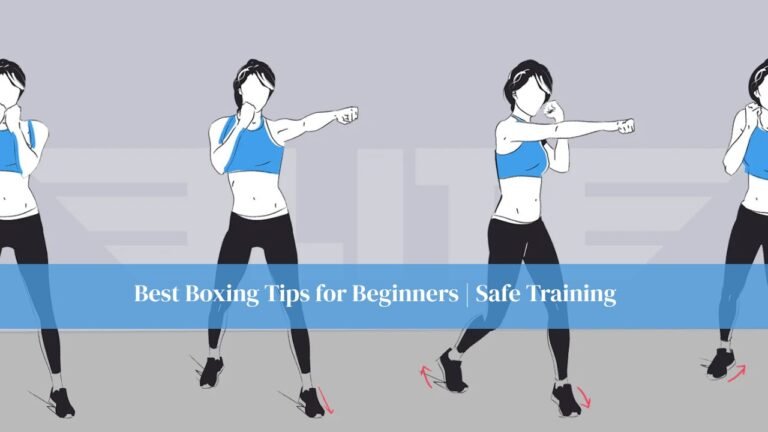Boxing is a sport that demands an incredible combination of strength, agility, and endurance. It’s a high-intensity discipline where every muscle plays a role, and while most people focus on the need for powerful punches, lightning-fast reflexes, and precise footwork, one crucial muscle group is often overlooked the biceps. These muscles are not just for show or aesthetics; they are essential for power generation, punching efficiency, control, and injury prevention. A well-developed set of biceps can be the difference between a fighter who executes clean, powerful techniques and one who lacks the mechanical advantage to dominate in the ring.
Understanding the role of biceps in boxing means going beyond basic anatomy. In this article, we’ll explore the critical connection between bicep strength and boxing performance, discuss training strategies, and look at how this muscle group affects fighters across different weight classes.
Biceps and Boxing Techniques
In boxing, technique is everything, and the biceps play a more significant role than many realize. This muscle group is heavily engaged in the execution of various punches, blocks, and defensive maneuvers. Whether you’re delivering a jab, unleashing a hook, or defending against a blow, the biceps act as a stabilizing and driving force.
When a boxer throws a jab or a cross, the biceps work to extend and retract the arm with speed and control. The jab, often considered the most fundamental punch in boxing, demands rapid arm extension followed by immediate retraction to reset the guard position. Without strong biceps, this quick return can become sluggish, giving the opponent an opening. Similarly, the cross, a powerful straight punch, uses bicep activation to stabilize the arm’s path and control the impact.
Hooks and uppercuts bring the biceps into an even more dominant role. A hook involves a rotational arm movement, where the biceps help generate torque and add force behind the strike. The biceps stabilize the elbow joint, ensuring that the punch lands with precision rather than wild, uncontrolled power. For uppercuts, the upward motion is driven in part by the biceps working alongside the shoulders and back muscles to lift and strike with authority from beneath an opponent’s guard.
Defensively, biceps strength enhances a boxer’s ability to block, parry, and absorb blows. When an opponent’s punch is incoming, the biceps engage to control the forearm position, soften the impact, and redirect the force away from vulnerable areas. Over time, boxers with stronger biceps find they can maintain their defensive posture longer without fatigue, which is crucial during later rounds when stamina becomes a deciding factor.
Building Functional Bicep Strength for Boxing
In boxing, it’s not enough to simply have large, muscular arms. The strength must be functional meaning it can be applied directly to the sport’s demands. This is where boxing-specific strength training comes into play. While traditional exercises like dumbbell curls remain effective for isolating the biceps, they should be paired with movements that replicate boxing mechanics.
Resistance band training offers a unique advantage because it provides constant tension through the entire range of motion, mirroring the resistance felt when punching. This not only strengthens the biceps but also conditions them for endurance, ensuring they remain explosive during a full-length bout. Similarly, compound exercises like pull-ups and chin-ups build overall arm and back strength, which contributes to a boxer’s punching speed and defensive control.
Shadowboxing with light weights is another functional approach. By holding small dumbbells during shadow boxing rounds, fighters train their biceps to work under slight resistance, which can make actual punching in the ring feel faster and more powerful.
Biceps and Injury Prevention in Boxing
The high-impact nature of boxing means that injury prevention is just as important as performance enhancement. The biceps, being heavily involved in punching and blocking, are at risk of strains, tears, and overuse injuries. This makes targeted conditioning and recovery practices vital for every serious boxer.
A proper warm-up routine before training or competition is essential. Increasing blood flow to the muscles reduces stiffness and prepares the biceps for explosive movements. Stretching after training sessions helps maintain flexibility and reduces post-exercise tightness that can contribute to overuse injuries.
Maintaining correct punching form is equally important. Poor technique can place unnecessary stress on the biceps, especially if the arm is overextended or the wrist is misaligned. Working with an experienced coach ensures that your punching mechanics protect the muscles and joints.
Rest and recovery cannot be ignored. Overtraining the biceps without sufficient downtime can lead to chronic fatigue and a greater risk of injury. Sleep, nutrition, and active recovery techniques like massage or foam rolling all contribute to keeping the biceps healthy and competition-ready.
The Role of Biceps Across Weight Classes
Bicep importance is not limited to one weight category. Across all divisions, from heavyweights to featherweights, this muscle group influences performance but in different ways depending on a fighter’s style and physical build.
In heavyweight boxing, biceps are integral to delivering knockout power. These athletes often have visibly larger and more developed biceps that contribute to the massive force behind their punches. The extra muscle mass not only increases impact power but also helps absorb punishment from equally strong opponents.
Middleweight fighters rely on a balance between power and speed. For them, bicep strength must support quick combinations without sacrificing punching force. A middleweight with well-conditioned biceps can deliver rapid jabs and sharp hooks, controlling the pace of the fight while still carrying enough force to stop an opponent in their tracks.
Lightweights often prioritize agility and stamina, but they cannot afford to neglect biceps training. Strong biceps help maintain high punch output over multiple rounds and ensure that each strike lands with speed and precision. For technical fighters in this category, bicep strength supports the fluidity of complex combinations and counters.
In the featherweight and below categories, speed is king. Fighters in these divisions often throw a high volume of punches per round, which demands exceptional muscular endurance in the biceps. Even a slight advantage in arm strength can help them dominate exchanges, outpace opponents, and maintain defensive sharpness deep into the fight.
Beyond the Ring The Broader Benefits of Strong Biceps
While the focus here is boxing, strong biceps also have everyday functional benefits. Improved arm strength supports better posture, assists in lifting and carrying tasks, and reduces the risk of injury in other sports or physical activities. For boxers, this means that the gains made in training translate to improved overall athleticism and resilience.
Furthermore, strong biceps can contribute to a boxer’s psychological edge. Knowing that your arms are powerful and well-conditioned can boost confidence, which often plays a decisive role in competitive sports. Confidence allows fighters to commit fully to their punches and defensive maneuvers without hesitation, which can influence the outcome of close matches.
Conclusion
In the competitive world of boxing, the biceps are far more than a cosmetic muscle group. They play a pivotal role in delivering powerful punches, maintaining defensive stability, and reducing injury risk. Across all weight divisions, fighters benefit from developing functional bicep strength tailored to the unique demands of the sport.
By combining targeted training, proper technique, and smart recovery practices, boxers can ensure their biceps work as an asset rather than a liability. Whether you are a heavyweight looking for knockout power, a lightweight aiming for lightning-fast combinations, or a beginner building your foundation, prioritizing bicep development can significantly improve your performance in the ring.
Ultimately, the journey to stronger biceps is not about lifting the heaviest weights possible but about building practical, boxing-specific strength. When trained correctly, your biceps will help you punch harder, defend better, and stay healthier throughout your career. In boxing, every muscle matters — and the biceps deserve the recognition and training they’ve long been denied.
FAQs
Can I skip bicep training and still be a successful boxer?
While you can skip it, strong biceps are a significant advantage in boxing.
What are the best foods for bicep growth in boxing?
Foods rich in protein and nutrients like lean meats, eggs, and dairy are excellent choices.
Are supplements safe for boxers?
Supplements can be safe if used cautiously and under professional guidance.
Related Post:




